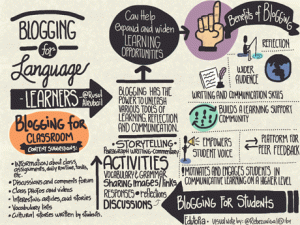Blogging for English-Language Learners
Student blogging provides opportunities for sharing, reflection, and ownership. With ELLs, blogs can provide deeper engagement and a public forum to demonstrate their developing skills.
Blogging is a very powerful tool in and of itself. Whether it's a personal or professional blog, blogging has the power to unleash learning, reflection, and communication. Even more, a blog can help spread your words and ideas to a wider audience and, as a result, a wider reach.
Blogging for English-language learners (ELLs) can tap into students' and teachers' utmost communicative potential and help expand and widen learning opportunities.
Benefits of Blogging
It's important for the teacher to discuss the benefit of blogging with her or his students, as this will inform how they learn through it. When students understand the benefits of the process, they become engaged and active in their own learning. Teachers should explain how blogging. . .
- Provides an opportunity for reflection by students and their teacher
- Opens up student writing to a wider audience
- Provides an opportunity to practice writing and communication skills
- Builds a learning support community
- Empowers student voice
- Provides a platform for peer feedback
- Motivates and engages students in higher-level communicative learning

How to Start Blogging in ELL Classrooms
It's probably best to start planning on incorporating blogging in your classroom sometime before the term begins. In this way, the process of integrating it into your schedule becomes less overwhelming, and much more manageable. The benefits for the teacher and students will always outweigh the bit of planning needed to start.
There are several ways to use blogging in your classroom:
Blogging for Students
A student blog can have many purposes in an ELL classroom:
- Discussions
- Responses
- Reflections
- Sharing images, links, and resources
- Vocabulary and grammar activities
- Paragraph writing
- Commentary
- Storytelling
These are just a few examples of what students can do with blogging. There are some great platforms for student blogs, such as Kidblog, Edublogs, Blogger, and even Write About, which is a publishing platform that allows groups (or classes) to post publicly and privately. To choose the right platform for you and your students, set aside some time to experience and create your own "example" blog. This example blog will not go to waste, because you'll use it to share with your students when introducing them to blogging.
How often should students blog?
This can be determined by the teacher and students as they see fit within the learning outcomes they're trying to accomplish. However, blogging consistently about the course discussions, materials, and content will allow students to delve into a deeper self-reflective process. They'll be able to trace their learning through their blogs and may be able to use them as studying material. Many students will end up using their blogs after the course or term has ended, and likely will maintain the same level of professionalism to build their digital identity.
How can peers and teachers provide feedback?
Feedback is an essential part of blogging. Since blogging is a very reflective process, students will need to stay engaged. The feedback provided by their peers or the teacher can be very valuable in providing this type of reflective engagement throughout the learning process. When ELL students work on peer feedback, there are several areas on which they can focus:
- Share one positive thing about the post.
- Share one thing their peers can work on or improve.
- Share a personal story that relates to the blog post.
For teachers, it's best to give constructive criticism on students blogs privately. That way, the conversation does not hinder the student's writing and thought process. By focusing on only the positive comments that a student receives on his or her blog post, the teacher can encourage and motivate that student to continue blogging and publicly sharing thoughts.
Blogging for Classrooms
A classroom blog is also a great idea for most classes. In ELL classes, however, a classroom blog can help with:
- Clarifications
- Understanding
- Communication
- Language development
- Parent-student engagement
What should an ELL classroom blog include?
To decide on the content of a classroom blog, a teacher can use this as a fun collaborative activity and have students brainstorm together to determine their needs. This not only motivates them to take initiative in creating the blog and its content, but it also allows them to own their own learning. When ELL students feel comfortable and in control of lesson tasks, their communication improves as a result of practice.
Here are some content suggestions:
- Information about class, assignments, daily routine, tasks, etc.
- Discussion and comments forum
- Class photos and videos
- Photos and videos of resources related to classwork
- Interesting articles and stories
- Vocabulary lists
- Links to resources, games, and fun ways to learn English
- Cultural stories written by students
The possibilities are really endless when it comes to classroom blog content. The key is personalizing it with the students to meet their communicative and learning needs.
Resources for Getting Started
Please take a look at my slideshare about blogging for English-language learners.
Below are some examples of classroom blogs:
- Larry Ferlazzo:
Have your ELL students blogged? Please share your results and impressions in the comments section.
